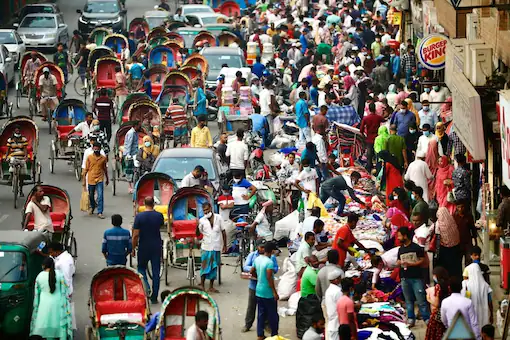The warmth of people and the magic of old Dhaka overwhelms you. Having said that, Dhaka is bursting on the seams with a gushing sea of humanity, unregulated construction and traffic jams defining the urban ethos.
Spending a few days in Dhaka was an overpowering experience. The warmth of people and the magic of old Dhaka overwhelms you. Having said that, Dhaka is bursting on the seams with a gushing sea of humanity, unregulated construction and traffic jams defining the urban ethos. Most people I met had fondness for Pakistan and it appeared that the old wounds are gradually getting healed. In fact the younger Bangaldeshis want to move on.
 I could not help thinking of Faiz’s only poem on the East Pakistan tragedy, written in 1974, on how those who were so close became estranged. Ham ke thehre ajnabi.. has been beautifully translated by Agha Shahid Ali and found here with the Urdu text:
I could not help thinking of Faiz’s only poem on the East Pakistan tragedy, written in 1974, on how those who were so close became estranged. Ham ke thehre ajnabi.. has been beautifully translated by Agha Shahid Ali and found here with the Urdu text:
After those many encounters, that easy intimacy,/we are strangers now –
After how many meetings will we be that close again?
When will we again see a spring of unstained green?/After how many monsoons will the blood be washed/from the branches?
So relentless was the end of love, so heartless –
After the nights of tenderness, the dawns were pitiless,/so pitiless.
And so crushed was the heart that though it wished/it found no chance –
after the entreaties, after the despair — for us to
quarrel once again as old friends.
Faiz, what you’d gone to say, ready to offer everything,/even your life –
those healing words remained unspoken after all else had /been said.
I was told by many Pakistan-Bangladesh bhai bhai and how the Bangladeshis support the Pakistan cricket team. Given the World Cup euphoria and better than expected performance of the Bangladeshi team, almost everyone sympathised over the defeat of Pak team and expressed sorrow over Bob Woolmer’s death . As I passed the Curzon Hall built in 1905 on my first day in the city, I knew that I would return. I struggled with time and before catching my plane I stopped by at the Curzon Hall and Shaheed Minar (built in the memory of martyrs for Bangla linguistic and political identity). Curzon Hall (now a part of Dhaka University campus) is a stunning building and fuses the Indian and Western traditions of architecture. A student of Dhaka University, Shahin who was pleased to hear that this is a major symbol in Iqbal‘s poetry took me around and showed the entire campus. It is a sprawling campus right in the city centre and rather inspiring.
. As I passed the Curzon Hall built in 1905 on my first day in the city, I knew that I would return. I struggled with time and before catching my plane I stopped by at the Curzon Hall and Shaheed Minar (built in the memory of martyrs for Bangla linguistic and political identity). Curzon Hall (now a part of Dhaka University campus) is a stunning building and fuses the Indian and Western traditions of architecture. A student of Dhaka University, Shahin who was pleased to hear that this is a major symbol in Iqbal‘s poetry took me around and showed the entire campus. It is a sprawling campus right in the city centre and rather inspiring.
Bangaldesh’s population profile, like many other countries is skewed in favour of the youth.  There are young men and women everywhere walking with energy, hope and promise. A photo exhibition by students that I visited in a rush was breath-taking. The subject matter and professionalism were striking.
There are young men and women everywhere walking with energy, hope and promise. A photo exhibition by students that I visited in a rush was breath-taking. The subject matter and professionalism were striking.
 By chance I also stopped at the Dargah of Shah Ali Baghdadi. The taxi driver somehow figured my inclinations and took me there. It was a lovely shrine full of devotees and serenity. The two old banyan trees reminded me of all the dergahs in South Asia.
By chance I also stopped at the Dargah of Shah Ali Baghdadi. The taxi driver somehow figured my inclinations and took me there. It was a lovely shrine full of devotees and serenity. The two old banyan trees reminded me of all the dergahs in South Asia.
There is a lovely mural dedicated to the national poet Nazrul Islam on a public roundabout. Tagore and Nazrul represent the high-point[s] of Bangla language, literature and culture. This is why one cannot help notice how everyone is into music and singing. Even the rickshaw-wallahs break into occasional singing.
 Dhaka despite the run-down look is a charming and energetic place. It has islands of culture and beauty and indeed a thriving restaurant business. Having said that the traffic jams can be frustrating.
Dhaka despite the run-down look is a charming and energetic place. It has islands of culture and beauty and indeed a thriving restaurant business. Having said that the traffic jams can be frustrating.  Wish I had more time to go out of the capital and drive through the green vistas and the rice fields. Or to lose myself in the Sundarbans. I am sure there will be a next time.
Wish I had more time to go out of the capital and drive through the green vistas and the rice fields. Or to lose myself in the Sundarbans. I am sure there will be a next time.
I can see that we the Pakistanis are not far away from reclaiming our common heritage and turning that into a positive partnership that builds on a people-to-people bond rather than diplomatic and official niceties.



